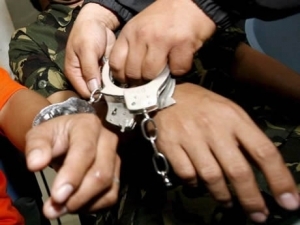Colombia captured a top commander of one of the country’s smaller drug-trafficking groups, Renacer (Rebirth). The existence of these minor paramilitary successor groups, like Cordillera and the Machos, presents a serious challenge to the Santos administration, which is struggling to deal with the fragmented criminal underworld.
Police announced the arrest of Erlin Javier Arroyo Mosquera, alias “Pocholo,” a former member of the paramilitary front Heroes of Choco, which is also known as the Pacific Bloc. He took part in the formal demobilization of that group in August 2005, but re-entered the criminal world and became an arms supplier for another paramilitary splinter group, Renacer, reports El Espectador.
Estimated to consist of no more than 90 members, Renacer is similiar to organizations like the Urabeños and the Paisas, drawing many of its recruits from former paramilitary blocs that failed to fully demobilize during the 2003-2005 peace process. Renacer is most active in the Pacific Bloc’s former stronghold, Choco, although it does have some reach into the Caribbean coast department Cordoba, where four alleged members were arrested during a surge in police operations in January 2011.
Even counting the number of these paramilitary successor groups, labeled BACRIM, or “bandas criminales,” by the government, has proved controversial. The government has only acknowledged the existence of seven BACRIMs, which, according to Defense Minister Rodrigo Rivera, marks a significant drop from the 33 criminal gangs registered in 2006. The police, meanwhile, have acknowledged eight, according to a 2010 report by Human Rights Watch. Colombian think-tank Indepaz counted fifteen in a study released last year.
As the top levels of AUC command were jailed, killed off, or extradited, middle and low-ranking paramilitaries like Arroyo Mosquera stepped up to fill the void. Some mid-level commanders, like the Usuga brothers of the Urabeños, were able to control their armed followers; others, like the Oficina de Envigado, saw their groups splinter as dissenting commanders broke away and formed their own criminal cells.
In Renacer’s case, three former mid-level commanders of the Calima Bloc, a paramilitary group based in Valle del Cauca and Choco that once controlled the Pacific Bloc, now reportedly head the group. They include Jose Negrete Luna, whom the U.S. Treasury Department has designated a top drug trafficker under the Kingpin Act.
The existence of groups like Renacer — alongside other minor paramilitary successor groups like Nueva Generacion (reportedly active in Nariño) and the fragmented Aguilas Negras — points to the failings of the United Self-Defense Forces of Colombia (Autodefensas Unidas de Colombia – AUC) demobilization. The peace process broke the AUC into a number of smaller and weaker groups which had little interest in influencing politics and who, in many cases, bought coca base from their former rivals, the Revolutionary Armed Forces of Colombia (Fuerzas Armadas Revolucionarias de Colombia – FARC). Not unlike the situation in Mexico, this fragmentation of actors has upped violence levels across Colombia.
In some ways, the challenge facing the Santos administration is to break down larger, powerful groups like the Rastrojos into smaller, more manageable groups like Renacer. This would likely increase violence in the short-term, but would remove the overwhelming threat posed by the larger groups, which have the capacity to penetrate the state, buy off the security forces, and threaten civilians with overwhelming levels of violence.
But the Catch-22 remains: As the government ups the pressure on big drug-trafficking organizations, causing them to fragment and break apart, it creates more criminal groups, with more competition between them, and hence more violence as rivals battle to control trafficking routes. The question is whether, at some point, the violence will begin to fall to more “acceptable” levels.
Viewed in terms of realpolitik, the Colombian state may not be able to fully dismantle the Rastrojos (who, after all, are successors to the Norte del Valle Cartel, itself a successor of the Cali Cartel). But the state may be able to turn the Rastrojos into a group like Renacer.

